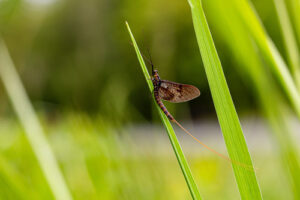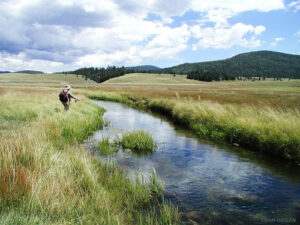Fly Fishing Tips And Tricks.

I’m a very keen angler and when I get to my fishing spot, the first thing I want to do, is run down to the water’s edge and throw some flies in. (Not literally. I mean cast aggressively and cover a lot of water.)
But rushing in can cost you a lot of fish. So, I try and slow my actions down, and follow these fly fishing tips and tricks.
One of the first steps to successful fly fishing, isn’t fishing at all. It is just observing the water and surroundings for a while.
Spend a few minutes, or so to watch and see if you can observe any fish feeding. Take a look and see what food and cover is about.
Stand well back from the water’s edge. Doing this also stops you scaring a fish that is feeding right on the water’s edge. Standing back, you are more likely to spot the fish first.
You actually can observe the environment better stationary, then moving. If you are walking, you might miss seeing small spent insects on the water. Or hear the exciting sound of trout rising, or slurping down insects.
It takes a bit of time to let your senses absorb your surroundings. So stop walking and talking and just look and listen.
If you have a fair hike along the river or lake edge, pause every so often and scan around.
Scanning the water for feeding fish is made easier with a wide brimmed hat and good polarized sunglasses.
These sunglasses help cut the glare from the water and can help spot fish in clearer water easily. A good pair of polarized sunglasses should be part of every fly fisherman’s equipment. Or every fisherman’s kit.
Look around weed beds, over hanging vegetation and timber in the water. Even if there is no fish feeding activity close to the surface, these areas might be good for casting around, later on at dusk.
Some anglers break lakes and rivers up into sections to scan, before moving on. Such as close by first, further away, left, center, right areas, etc.
More fly fishing tips and tricks.

If you do find feeding fish, how are they feeding? What are the fish doing? What are they chasing? Can you see the fly they’re eating? If you don’t see them rising, a nymph might be in order.
Take note of what insects are about. Are the fish feeding on these?
Look for evidence of recent hatches in the water and along the waters edge. Can you find any clues of a recent mayfly hatch?
If you see a lot of a certain kind of insect hanging around, you can bet on patterns that imitate that insect when you get to the stream might be worth a go. Where the bugs are, is probably where the fish are.
Turn up the odd submerged rock and logs, carefully looking for stoneflies, nymphs, etc. Make sure you put it back though and try not to disturb the environment.
Birds feeding around the water are good signs of food available, like swallows swooping down picking up mayflies.
For saltwater fly fishing, flocks of diving birds picking up baitfish are great indicators.
On strong onshore windy days, foam is whipped up around the lakes edges. The foam is worth scooping up and looking at it closely. Stick caddis, beetles and nymph casing might be blown into the foam, which can sometimes get sticky and hold the insects. Trout understand this and take advantage of the trapped insect soup.
A lot of fly fisherman avoid looking at the windy lake sides, as casting can be difficult and uncomfortable. However, the wind blows a lot of food around the edges and is worth investigating.
The opposite side of lakes, the offshore side, can just be as productive on windy days. As fish may cruise waiting for grasshoppers, ants, crickets and beetles waiting to be blown on to the lake or river.
Over hanging trees and shrubs are worth watching for food. If you see a lot of a certain kind of insect hanging around the brush, you can bet on patterns that imitate that insect when you get to the water are worth trying.
Some other fly fishing tips and tricks are to shake a branch, or shrub. This can give you an indication of the insects about as they fly off. Also you might even start your own artificial hatch and get the fish excited by the insect falling in the water.

Take a look at grass stems and weeds near the shore line for clues of a recent hatch. You might find mudeye casings, from recently hatched dragon flies. Around old stumps and trees are worth looking at before you even wet the line, as you know what type of food is about.
Spider webs are a great place to look for clues. Most spiders keep their web reasonably clean so you may be able to tell if it is a recent hatch. If the insects look old, you will know for fishing next time what other aquatic life is about.
Watching the water is time well spent as you can find what the fish are feeding on. What other types of insect are about, possible hot areas to cover and what is the best imitation fly to use. All this valuable information is available to you and you haven’t even cast the fly yet!
It can be counter intuitive, but taking your time and observing the water and surrounds, before fishing, can actually save your time and increase your catch rate.
For more fly fishing tips and tricks visit, How To Fly Fish, fly casting for beginners.
Resources